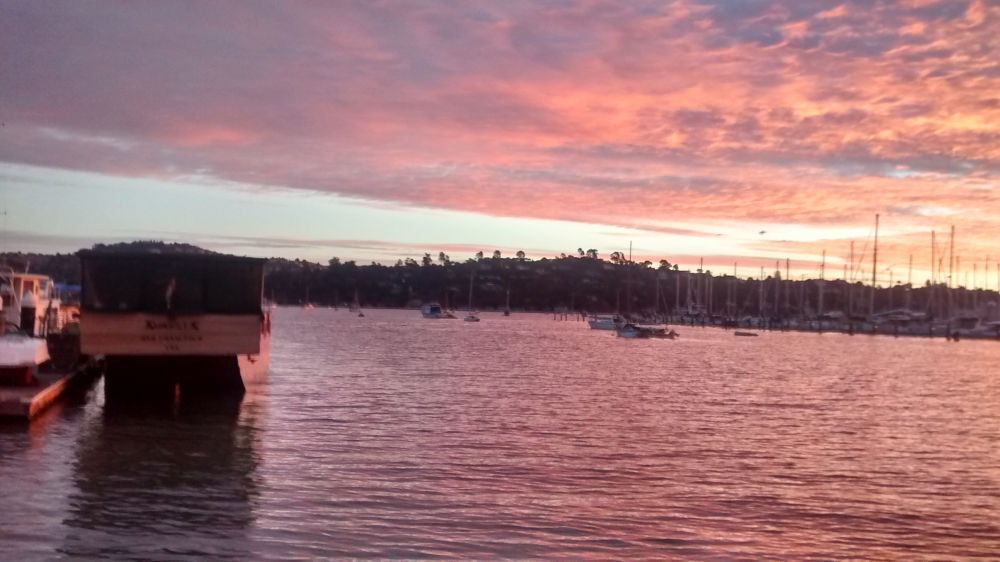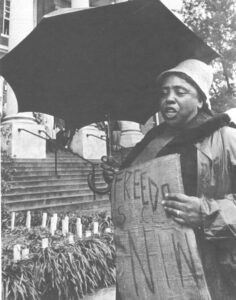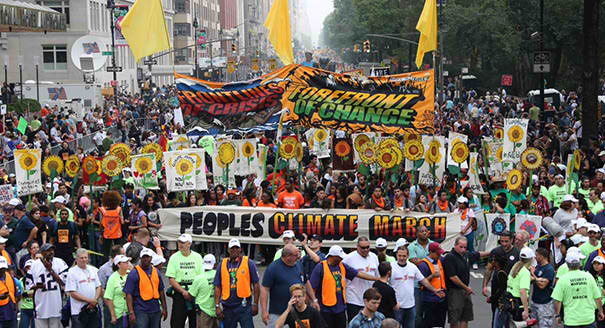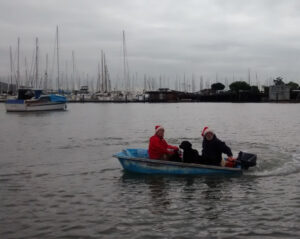 ‘Put down your bucket where you are’ was Howard Zinn’s prescription for social change.
‘Put down your bucket where you are’ was Howard Zinn’s prescription for social change.
My small red bucket is here on my boat. And my boat life fulfils the distilled advice given by a friend, “choose happiness.” Sausalito must be one of the most joyful places I’ve ever lived.
Floaty boat living is also a great place for contemplation. Especially when working for an organization like Global Fund for Women, with its commitment to women’s human rights globally.
Recently I was in Lima, Peru for a gathering of our grantee partners – women’s human rights defenders and activists working in Latin American countries. Here, women’s rights activists shared their struggles for rights in every inter-connected form – land, education, work, sexual and reproductive health and rights, freedom from violence, and the need to address increasing militarization, and to fight for hard won gains in the face of sustained conservative backlash. This gathering was an opportunity to chart a course for collective action and to build strong political agendas to impact and achieve transformational change in the region.
As one participant said “We exist because we resist…injustice, violence, violations of human rights.”
While I was in Peru I also fell into a ditch and fractured my ankle.
Returning home, and to my little boat in Sausalito, I was told to rest. And then rest some more. This at a time of pre-holiday rush where so many people around me seemed to be infused with the spirit of white rabbit in Alice in Wonderland… I’m late, I’m late…
On my boat I had no such dates, just the here and now.
 Each day, 6 or 7 seals, including bull seals (arf, arf, arf) pop up out of the sea with their bright black eyes and whiskered faces and then chase herring to get their fill. Meanwhile, when the dawn is at hand, pelicans (those ancient birds) join hundreds of other birds in dive-bombing the water for their fill of fish.
Each day, 6 or 7 seals, including bull seals (arf, arf, arf) pop up out of the sea with their bright black eyes and whiskered faces and then chase herring to get their fill. Meanwhile, when the dawn is at hand, pelicans (those ancient birds) join hundreds of other birds in dive-bombing the water for their fill of fish.
This immersion experience of sea, stars, sky and all creatures kin has a sustained calming effect on me.
I re-watch my favorite movies on non-violence peace movements and social justice, Gandhi, Romero, The Mission, A Long Walk to Freedom, Cry the Beloved Country, and think about courage in the face of fire. Or with the gift of fire, if you listen to Sister Helen Prejean, author of Dead Man Walking, who, quoting from St Bonaventure said, “Ask not for the understanding; ask for the fire.”
“I have often been threatened with death,” Archbishop Oscar Romero told a Guatemalan reporter two weeks before his assassination on March 24, 1980. “If they kill me, I shall arise in the Salvadoran people. … Let my blood be a seed of freedom and the sign that hope will soon be reality.”
As the peace advocate, John Dear wrote, Oscar Romero gave his life for that struggle in the hope that the outcome was inevitable, that justice would be done, that war would be abolished, that truth will overcome, and that love and life are stronger than hate and death.
Romero’s conviction only increased with the threat of death. “Like a voice crying in the desert,” he said, “we must continually say No to violence and Yes to peace.” Romero’s last appeal before his death was to the members of the armed forces on March 23rd 1980. This was after Romero heard that President Jimmy Carter was considering sending millions of dollars a day in military aid to El Salvador. Deeply distressed, he wrote a long public letter to Carter, asking the United States to cancel all military aid. Carter never responded to Romero, and sent the aid.
And so Romero wrote to the armed forces saying
“I would like to make an appeal in a special way to the men of the army, to the police, to those in the barracks. Brothers, you are part of our own people. You kill your own campesino brothers and sisters. And before an order to kill that a man may give, the law of God must prevail that says: Thou shalt not kill! No soldier is obliged to obey an order against the law of God. No one has to fulfill an immoral law. It is time to recover your consciences and to obey your consciences… In the name of God, and in the name of this suffering people whose laments rise to heaven each day more tumultuously, I beg you, I ask you, I order you in the name of God: Stop the repression!”
Romero’s appeal to individuals to recover their moral conscience is not just an historic act, it’s a reminder to us all to pay attention here. Gandhi was clear that ‘we must be the change we wish in the world. This includes kinetically rewiring our own potential for violence and channeling it into an active peace.
As Helen Prejean has written, the ‘active’ part of non-violent resistance, as employed by Gandhi in India and by Martin Luther King in the American South, proved to be the most powerful force imaginable on the powers King and Gandhi were trying to overturn.
The writings of both men are filled with references to love as a powerful force against oppression, and while the two leaders were not using the term” force” in the military sense, they certainly regarded nonviolence as a tactical force as well as an expression of high moral principle.
Social movements for democracy, peace, civil rights, LGBTI rights, women’s rights, land rights, labor rights, climate justice, girls’ rights, black men’s “hands up don’t shoot” rights, dreamers’ immigration rights have been shown to be one of the most effective mechanisms for including excluded populations in the political process.
These movements are themselves a sustained political act to change policies, laws, behavior, beliefs and systems in the service of justice, equality, peace and love. They are not undertaken on behalf of ‘the other’ but rather in recognition of our connectedness.
As Robert Moses in recruiting Northern Whites for Freedom Summer in the Deep South said “Don’t come to Mississippi this summer to save the negro. Only come if you understand, really understand, that his freedom and yours are one.”
 People’s courage and tenacity to stand and hold their ground in the face of terror and injustice is phenomenal, as evidenced by that extraordinary book and film A Force More Powerful
People’s courage and tenacity to stand and hold their ground in the face of terror and injustice is phenomenal, as evidenced by that extraordinary book and film A Force More Powerful. In Dennis McNally’s book, On Highway 61: Music, Race, and the Evolution of Cultural Freedom
, he reminds us of Fannie Lou Hamer who’d found out in 1961 at the age of 45 that she was entitled to vote. ‘A woman of profound faith, she’d gone to the courthouse singing ‘This Little Light of Mine’ and, when she was subsequently evicted from the plantation for this action, she felt set free to join the movement. Savagely beaten after an arrest, she said, “Sometimes it seems like to tell the truth today is to run the risk of being killed. But if I fall, I’ll fall five feet four inches forward in the fight for freedom.”
Naomi Klein, in her book, This Changes Everything, has written powerfully about the potential of movement building to not just be a circuit breaker for climate change impact, but to rewire the world.
‘Only mass movements can save us now…any attempt to rise to the climate challenge will be fruitless unless it is understood as part of a much broader battle of worldviews, a process of rebuilding and reinventing the very idea of the collective, the communal, the commons, the civil and the civic after so many decades of attack and neglect.
‘..when major shifts in the economic balance of power take place, they are invariably the result of extraordinary levels of social mobilization. At those junctures, activism becomes something that is not performed by a small tribe within a culture…an entirely normal activity throughout society…During extraordinary moments – both world wars, the aftermath of the great Depression, or the peak of the civil rights era – the usual categories dividing “activist” and “regular people: became meaningless because the project of changing society was so deeply woven into the project of life. Activists were, quite simply everywhere….(and) when fundamental change does come, it…comes in spasms of rapid-fire lawmaking, with one breakthrough after the other.
Think here about Gandhi’s salt march being a march that secured an independent India, the social movements for peace and freedom ending the violence in Northern Island, the sustained people’s movement securing the fall of the Berlin Wall, the women activists in Liberia helping to end the civil war there and mobilize to see the first democratically elected female President assume power.
‘Fundamentally, the task is to articulate…an alternative worldview to rival the one at the heart of the ecological crisis – embedded in interdependence rather than hyper-individualism, reciprocity rather than dominance, and cooperation rather than hierarchy. This is required not only to create a political context to dramatically lower emissions but also to help us cope with the disasters we can no longer avoid. Because in the hot and stormy future we have already made inevitable through our past emissions, an unshakable belief in the equal rights of all people and a capacity for deep compassion will be the only thing standing between civilization and barbarism.’
In her book Klein speaks of the forces of resistance coming from the elite minority that wield phenomenal power and influence and have the most to lose from action on climate change that challenges unregulated capitalism. The power of elites was also captured in an important editorial in The New York Times on December 25th. The editorial shared the results of a study undertaken by The Echo Chamber of the petitions submitted to the Supreme Court from 2004 – 2012 and reported by Reuters.
Reviewing the findings, Reuters reported that, of the some 10,000 petitions filed by private attorneys each year, about 75 cases are accepted. Reuters found that the lawyer’s name on the brief was one of the strongest indicators of whether the case would get heard. While the 66 lawyers whose cases were heard represented less than half of 1% of all lawyers who petitioned the Supreme Court from 2004-2012, they were involved in 43% of the cases the justices heard. Of these lawyers, 63 of the 66 lawyers were white, 58 were men, and 51 worked with firms with primarily corporate clients.
Klein was compelling as a speaker at the Bioneers conference a few months ago when she spoke of industrial capitalism being at war with life on earth and that climate change can be the glue that binds together all social movements.
She was joined by other speakers, equally compelling in their advocacy and analysis. Clayton Thomas-Muller, leader of theIdle No More movement, spoke of climate change being the civil rights movement of our time and of violence against women and violence against the earth being the greatest issues of our time.
As Naomi Klein said at the conference, ‘a new movement is rising. Rooted in localism with fierce connection to place and yet highly connected and dynamic.
And that is why I’m leading a meeting to discuss the potential for a People’s Climate Fund on January 20th (sign up here http://www.meetup.com/Peoples-Climate-Fund-Meetup-Sausalito/events/218845180/) Joining the hundreds of thousands of other people at the People’s Climate March in New York gave me a sense of the power of people led change to achieve the level of change, and the type of changes we need to see.

 Which brings me back to the wilding force of nature and to what writer Wendell Berry calls ‘love for local things, rising out of local knowledge and local allegiance.’
Which brings me back to the wilding force of nature and to what writer Wendell Berry calls ‘love for local things, rising out of local knowledge and local allegiance.’
Last weekend we had the Lighting of the Boats as dozens of boats glided across Sausalito moonlit waters with gorgeous Christmas carols playing and people gathered on boats and on the shoreline. My neighbor, Joe, created his own light display with a 20 foot lighted heart installed on the top of his boat, “beaming love out to the world”.
 I wake early each morning to the sweetest scenes of seals and birds at play, and an occasional otter, together with people on small rowboats, often with their dogs for company and many decked with red hats and tinselly bits as a nod to the holiday season.
I wake early each morning to the sweetest scenes of seals and birds at play, and an occasional otter, together with people on small rowboats, often with their dogs for company and many decked with red hats and tinselly bits as a nod to the holiday season.
Most recently, I assisted with a fur seal pup release as we returned these gorgeous creatures to the sea. (see the vid below)
There‘s a crackling energy and magic in these encounters. It reminds me of an observation by Peter Matthiessen, one of the great environmental, spiritual, humanist writers of this age, who died recently. In one my favorite books of his, The Snow Leopard, Matthiessen captures the sense I often feel flowing through me, on this boat, in this life:
[symple_testimonial by=”Peter Matthiessen” fade_in=”false”]“In his first summers, forsaking all his toys, my son would stand rapt for nearly an hour in his sandbox in the orchard, as doves and redwings came and went on the warm wind, the leaves dancing, the clouds flying…the child was not observing; he was at rest in the very center of the universe, a part of things, unaware of endings and beginning, still in unison with the primordial nature of creation, letting all light and phenomena pour through.”[/symple_testimonial]
[symple_box color=”black” fade_in=”false” float=”center” text_align=”left” width=””]
Update
Huge thanks to Sean Bogle of wildlensinc.org for sharing his “Northern fur seal release” video
Helping the Marine Mammal Center here in Sausalito, to return these gorgeous Northern fur seals to the sea.
[/symple_box]
Jane Sloane
San Francisco
The day will come when letters such as Archbishop Romero’s will be no longer something we read in history books, for we will carry his message embedded in our hearts,in our minds…they will become the doctrine we live by. And peace walks such as the ones that Gandhi and Dr.King headed will be not isolated events,they will be the direction we take in all our walks. We won’t be be looking for people to join the movement,we’ll be looking for places that need our attention,areas that need change. Strenght being counted in numbers,can only be achieved by teaching our children that “one is not us”, “I am” subsequently will become “we are” . Lets teach them that although we are individuals ,we are part of a whole,a whole that needs our attention, that needs “us” for change.